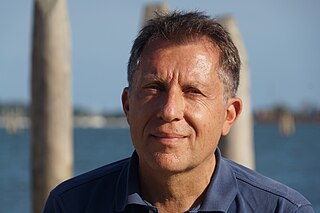
Space is the boundless three-dimensional extent in which objects and events have relative position and direction. Physical space is often conceived in three linear dimensions, although modern physicists usually consider it, with time, to be part of a boundless four-dimensional continuum known as spacetime. The concept of space is considered to be of fundamental importance to an understanding of the physical universe. However, disagreement continues between philosophers over whether it is itself an entity, a relationship between entities, or part of a conceptual framework.
Social geography is the branch of human geography that is most closely related to social theory in general and sociology in particular, dealing with the relation of social phenomena and its spatial components. Though the term itself has a tradition of more than 100 years, there is no consensus on its explicit content. In 1968, Anne Buttimer noted that "[w]ith some notable exceptions, (...) social geography can be considered a field created and cultivated by a number of individual scholars rather than an academic tradition built up within particular schools". Since then, despite some calls for convergence centred on the structure and agency debate, its methodological, theoretical and topical diversity has spread even more, leading to numerous definitions of social geography and, therefore, contemporary scholars of the discipline identifying a great variety of different social geographies. However, as Benno Werlen remarked, these different perceptions are nothing else than different answers to the same two questions, which refer to the spatial constitution of society on the one hand, and to the spatial expression of social processes on the other.

Queer theory is a field of critical theory that emerged in the early 1990s out of the fields of queer studies and women's studies. "Queer theory" can have various meanings depending upon its usage. Two common usages of queer theory include a 1) methodology for literary analysis and 2) a productive practice of theory. A literary methodology could include queer readings of texts, that is, textual interpretations which are presented from a queer perspective. While the theorization of 'queerness' works to produce ideas which relate to how queerness can be understood in various disciplinary contexts.

A public space is a place that is generally open and accessible to people. Roads, public squares, parks and beaches are typically considered public space. To a limited extent, government buildings which are open to the public, such as public libraries are public spaces, although they tend to have restricted areas and greater limits upon use. Although not considered public space, privately owned buildings or property visible from sidewalks and public thoroughfares may affect the public visual landscape, for example, by outdoor advertising. Recently, the concept of Shared space has been advanced to enhance the experience of pedestrians in public space jointly used by automobiles and other vehicles.

Henri Lefebvre was a French Marxist philosopher and sociologist, best known for pioneering the critique of everyday life, for introducing the concepts of the right to the city and the production of social space, and for his work on dialectics, alienation, and criticism of Stalinism, existentialism, and structuralism. In his prolific career, Lefebvre wrote more than sixty books and three hundred articles. He founded or took part in the founding of several intellectual and academic journals such as Philosophies, La Revue Marxiste, Arguments, Socialisme et Barbarie, Espaces et Sociétés.

In phenomenology, the terms the Other and the Constitutive Other identify the other human being, in his and her differences from the Self, as being a cumulative, constituting factor in the self-image of a person; as acknowledgement of being real; hence, the Other is dissimilar to and the opposite of the Self, of Us, and of the Same. The Constitutive Other is the relation between the personality and the person (body) of a human being; the relation of essential and superficial characteristics of personal identity that corresponds to the relationship between opposite, but correlative, characteristics of the Self, because the difference is inner-difference, within the Self.

Madness and Civilization: A History of Insanity in the Age of Reason is a 1961 book by the French philosopher Michel Foucault. The book was first translated into English - in an abridged edition - in 1964. A new English translation of the complete 1961 edition, titled History of Madness, was published in June 2006.

Paul Rabinow is Professor of Anthropology at the University of California (Berkeley), Director of the Anthropology of the Contemporary Research Collaboratory (ARC), and former Director of Human Practices for the Synthetic Biology Engineering Research Center (SynBERC). He is perhaps most famous for his widely influential commentary and expertise on the French philosopher Michel Foucault.

Edward William Soja was a self-described "urbanist," a noted postmodern political geographer and urban theorist on the planning faculty at UCLA, where he was Distinguished Professor of Urban Planning, and the London School of Economics. He had a Ph.D. from Syracuse University. His early research focused on planning in Kenya, but Soja came to be known as the world's leading spatial theorist with a distinguished career writing on spatial formations and social justice.
Norbert Guterman (1900–1984) was a scholar, and translator of scholarly and literary works from French, Polish and Latin into English. His translations were remarkable for their range of subject matter and high quality.
Sexual meanings are the meanings that are attributed, by a particular cultural-social-historical context, to sexual acts and broadly to all the aspects of the erotic dimension of human sexual experience. This also include the beliefs on what is considered sexual and what is not. Sexual meanings are social and cultural constructs, and they are metabolized and subjectivized by the individual only after cultural and social mediation.
Heterotopia is a concept elaborated by philosopher Michel Foucault to describe certain cultural, institutional and discursive spaces that are somehow ‘other’: disturbing, intense, incompatible, contradictory or transforming. Heterotopias are worlds within worlds, mirroring and yet upsetting what is outside. Foucault provides examples: ships, cemeteries, bars, brothels, prisons, gardens of antiquity, fairs, Muslims baths and many more. Foucault outlines the notion of heterotopia on three occasions between 1966-67. A talk given to a group of architects is the most well-known explanation of the term. His first mention of the concept is in his preface to 'The Order of Things' and refers to texts rather than socio-cultural spaces.
Spatial justice links together social justice and space, most notably in the works of geographers David Harvey and Edward W. Soja. The organization of space is a crucial dimension of human societies and reflects social facts and influences social relations. Consequently, both justice and injustice become visible in space. Therefore, the analysis of the interactions between space and society is necessary to understand social injustices and to formulate territorial policies aiming at tackling them. It is at this junction that the concept of spatial justice has been developed.
The sociology of space is a sub-discipline of sociology that mostly borrows from theories developed within the discipline of geography, including the sub fields of human geography, economic geography, and feminist geography. The "sociology" of space examines the social and material constitution of spaces. It is concerned with understanding the social practices, institutional forces, and material complexity of how humans and spaces interact. The sociology of space is an inter-disciplinary area of study, drawing on various theoretical traditions including Marxism, postcolonialism, and Science and Technology Studies, and overlaps and encompasses theorists with various academic disciplines such as geography and architecture. Edward T. Hall developed the study of Proxemics which concentrates on the empirical analysis of space in psychology.
Practice theory is a theory which seeks to understand and explain the social and cultural world by analyzing the basic bodily, knowledge based practices that interconnect to form more complex social entities like groups, lifestyles, social fields or entire societies. Practice theory, as outlined by Sherry Ortner, "seeks to explain the relationship(s) that obtain between human action, on the one hand, and some global entity which we call 'the system's on the other". The approach seeks to resolve the conflict in classical social theory between collectivist structuralist approaches and individualist action theories which attempted to explain all social phenomena in terms of intentional individual actions.
Geocriticism is a method of literary analysis and literary theory that incorporates the study of geographic space. The term designates a number of different critical practices. In France, Bertrand Westphal has elaborated the concept of géocritique in several works. In the United States, Robert Tally has argued for a geocriticism as a critical practice suited to the analysis of what he has termed "literary cartography".
Spatial citizenship describes the ability of individuals and groups to interact and participate in societal spatial decision making through the reflexive production and use of geo-media. Spatial citizens are lay users who are able to use geo-media to question existing perspectives on action in space and to produce, communicate, and negotiate alternative spatial visions.

Jacques Lévy is a professor of geography and urbanism at the School of Architecture, Civil and Environmental Engineering of the École Polytechnique Fédérale de Lausanne (EPFL). He is the director of Chôros Laboratory and of the Doctoral Program in Architecture and Science of the City. He is the cofounder of the scientific journal EspacesTemps.net. He published in French, along with Michel Lussault, the dictionary of geography and space of societies, Dictionnaire de la géographie et de l’espace des sociétés.He has contributed to in the epistemological and theoretical reform of geography as a science of the spatial dimension of the social, open to the social sciences and philosophy. Starting from political geography, he has most notably explored the city, urbanity, Europe and globalization. He works also for the introduction of non-verbal languages, especially audio-visual languages, at all levels of research. In 2013 he made a feature film, Urbanity/ies, which is intended as a manifesto for scientific film.
The Observatoire de l’Espace is a cultural laboratory created in 2000 by CNES to promote a new vision of outer space, different from that of popular science. Space has a major influence on people’s perceptions and imagination. The Observatoire de l’Espace introduces artists to the activities of the CNES and paves the way for any kind of space-inspired creations. Those creations strongly connected to space art are thereafter shared with the wider audience.
Robert MacArthur Shields is a Canadian sociologist and cultural theorist. He is Professor and Henry Marshall Tory Endowed Research Chair at University of Alberta. Shields directs the City Region Studies Centre in the Faculty of Extension. From 1991-2004 he rose to Professor of Sociology and Directed the Institute for Interdisciplinary Studies at Carleton University, Ottawa Canada, with an interlude in 1995-97 as a Lecturer in Culture and Communications at Lancaster University, Lancaster UK.








